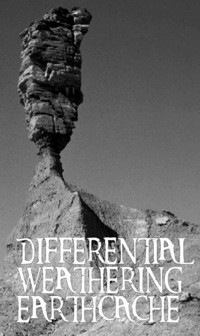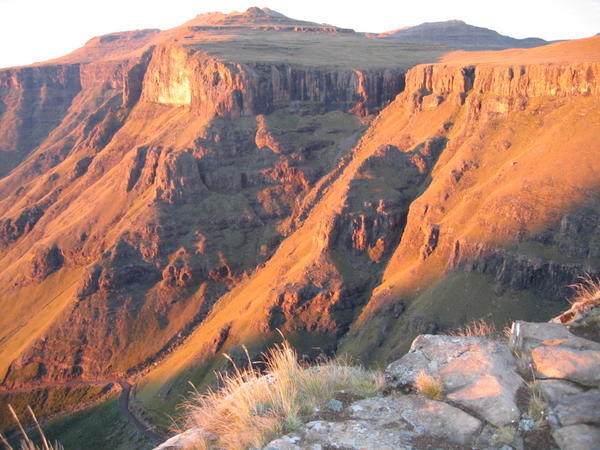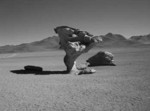
From the guidelines, as from January 2013"People do not need to wait for permission to log your EarthCache. Requiring someone to wait is not supported by the EarthCache guidelines. People should send their logging task answers to you, then log your EarthCache. When you review their logging task answers, if there is a problem, you should contact them to resolve it. If there is no problem, then their log simply stands."

Weathering -
Weathering causes the disintegration of rock near the surface of the earth. Plant and animal life, atmosphere and water are the major causes of weathering. Weathering breaks down and loosens the surface minerals of rock so they can be transported away by agents of erosion such as water, wind and ice.
What is differential weathering?
Different rocks weather at different rates. In warm, humid environments chemical  weathering is fast so granites and limestones tend to weather rapidly. In drier, colder environments, freeze-thaw is a major process of weathering and so layered rocks, especially shales tend to weather rapidly. This is the basics of the matter.
weathering is fast so granites and limestones tend to weather rapidly. In drier, colder environments, freeze-thaw is a major process of weathering and so layered rocks, especially shales tend to weather rapidly. This is the basics of the matter.
Differential weathering can also occur within the same rock type as a result of compositional differences. Often the rock mass, especially plutonic rocks, can be layered as a result of the greater concentration of one type of mineral. This distribution of minerals can be the cause of differential weathring phenomena.
The cliffs in this photo are formed by a layer of volcanic rocks underlain by shale/sandstone. The more easily weathered shale/sandstone is broken and moved down slope by gravity and rain. The quickly weathered material cannot support a  steep slope and so it does not form cliffs.
steep slope and so it does not form cliffs.  The volcanic rocks of the cliff are "strong" and weather slowly. It is, however, constantly undercut by the down slope movement of the weaker shale. Loosing support from underneath, blocks of the volcanic rock break off the cliff face and roll down the slope.
The volcanic rocks of the cliff are "strong" and weather slowly. It is, however, constantly undercut by the down slope movement of the weaker shale. Loosing support from underneath, blocks of the volcanic rock break off the cliff face and roll down the slope.
An example can be seen in the image of the Lesotho Highlands (Rep. South Africa; below). The Lesotho Highlands occur in central eastern South Africa and area mountainous area of unparalleled beauty. Most of this beauty stems from the fact that the sedimentation process was interrupeted periodically with flood basalts. The basalts (harder) create the vertical cliffs in the image while the sediments (softer), the more gentle slopes - a perfect example of differential weathering.

The cache:
The coordinates will take you to a small granite outrcrop where you can observe differential weathering. Here you are asked to face the outcrop (roughly south) and tell me how many ridges or troughs result from the process of differential weathering in the outrcrop in front of you. Send me the answer by e-mail through my profile to validate your log. Enjoy it!
ps. No photos in the logs that will give away the answer. Thanks.

O que é erosão?
A Erosão é a destruição da rocha à superfície da terra (e do solo também) e seu  transporte em geral feito pela água da chuva, pelo vento ou, ainda, pela acção do gelo, quando este actua expandindo o material no qual se infiltra a água congelada. A erosão destrói as estruturas (areias, argilas, óxidos e húmus) que compõem o solo. Estas são transportados para as partes mais baixas dos relevos e em geral vão assorear cursos de água.
transporte em geral feito pela água da chuva, pelo vento ou, ainda, pela acção do gelo, quando este actua expandindo o material no qual se infiltra a água congelada. A erosão destrói as estruturas (areias, argilas, óxidos e húmus) que compõem o solo. Estas são transportados para as partes mais baixas dos relevos e em geral vão assorear cursos de água.
O que é a erosão diferencial?
Processo erosivo que actua selectivamente sobre cada tipo de rocha, as mais resistentes à erosão formando relevos altos ou proeminentes e as mais fracas à erosão, zonas baixas e/ou relevos mais suaves.
 Erosão diferencial é, na realidade, a regra da formação do modelado terrestre, pois cada rocha de uma região responde de forma diferente de outra rocha ao mesmo processo erosivo. O seu estudo é um dos pontos chave da geomorfologia e da fotointerpretação. Por exemplo, camadas de quartzitos (quartzo é muito resistente ao intemperismo) tendem a formar zonas elevadas
Erosão diferencial é, na realidade, a regra da formação do modelado terrestre, pois cada rocha de uma região responde de forma diferente de outra rocha ao mesmo processo erosivo. O seu estudo é um dos pontos chave da geomorfologia e da fotointerpretação. Por exemplo, camadas de quartzitos (quartzo é muito resistente ao intemperismo) tendem a formar zonas elevadas  e cristas enquanto que xistos, com minerais menos resistentes ao intemperismo, como as micas, tendem a ocorrer em zonas mais baixas.
e cristas enquanto que xistos, com minerais menos resistentes ao intemperismo, como as micas, tendem a ocorrer em zonas mais baixas.
A erosão diferencial pode muitas vezes alterar aquilo que vemos à nossa frente e aquilo a que estamos habituados a ver à nossa frente. Um dos exemplos de como a erosão diferencial afecta as nossas paisagens é a Pedra da Gávea no Rio de Janeiro. Todos conhecem o Pão de Açucar com a sua forma arredondada mas a Pedra da Gávea teria sido simplesmente mais um "pão de açucar" se não tivesse por cima um corpo tabular de granito, e que, por ser mais resistente à erosão, a protegeu da erosão.

Mesmo aqui ao lado, e num local onde muito cachers já passaram, notam-se os efeitos de erosão diferencial com muita facilidade. A sul da Praia Grande (Sintra), as arribas estão pejadas de diques básicos (rochas vulcânicas). As rochas básicas, sendo mais porosas e por isso menos resistentes à erosão formam relevos negativos tal como na imagem seguinte:

A cache:
As coordenadas desta cache levam-te à Serra de Sintra perto do Convento dos Capuchos onde existe um pequeno afloramento granítico onde se pode observar o fenómeno da erosão diferencial. Junto a este afloramento quero que o observem e depois mandem-me uma mensagem através do meu profile com o número de estruturas em meia-cana neste afloramento. Estas estruturas podem ser vistas do estradão e não é preciso invadir a mata.
ps. Nada de fotos spoiler nos logs para não divulgar a resposta. Andar um pouco faz bem a todos.

 The most exciting way to learn about the Earth and its processes is to get into the outdoors and experience it first-hand. Visiting an Earthcache is a great outdoor activity the whole family can enjoy. An Earthcache is a special place that people can visit to learn about a unique geoscience feature or aspect of our Earth. Earthcaches include a set of educational notes and the details about where to find the location (latitude and longitude). Visitors to Earthcaches can see how our planet has been shaped by geological processes, how we manage the resources and how scientists gather evidence to learn about the Earth. To find out more click HERE.
The most exciting way to learn about the Earth and its processes is to get into the outdoors and experience it first-hand. Visiting an Earthcache is a great outdoor activity the whole family can enjoy. An Earthcache is a special place that people can visit to learn about a unique geoscience feature or aspect of our Earth. Earthcaches include a set of educational notes and the details about where to find the location (latitude and longitude). Visitors to Earthcaches can see how our planet has been shaped by geological processes, how we manage the resources and how scientists gather evidence to learn about the Earth. To find out more click HERE.
______________________________________________________________________________
